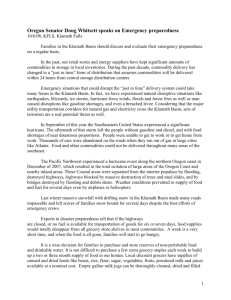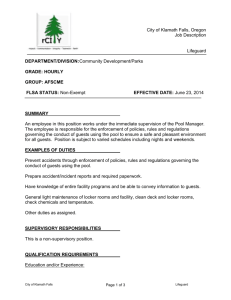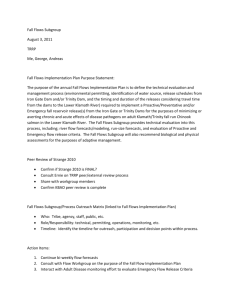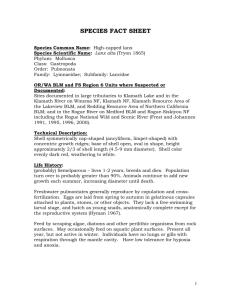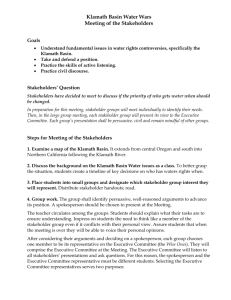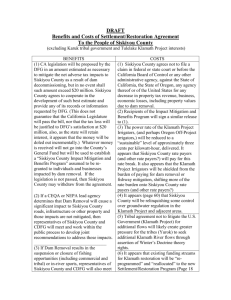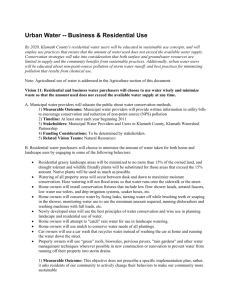Crisis Profiteering - Klamath Forest Alliance
advertisement
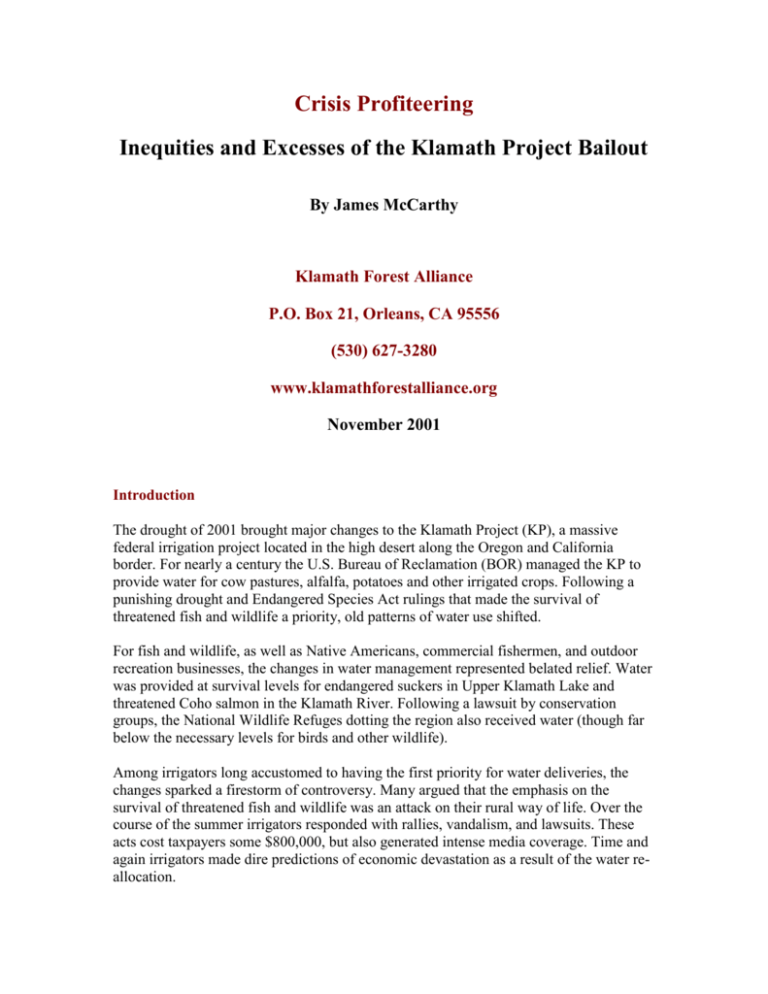
Crisis Profiteering Inequities and Excesses of the Klamath Project Bailout By James McCarthy Klamath Forest Alliance P.O. Box 21, Orleans, CA 95556 (530) 627-3280 www.klamathforestalliance.org November 2001 Introduction The drought of 2001 brought major changes to the Klamath Project (KP), a massive federal irrigation project located in the high desert along the Oregon and California border. For nearly a century the U.S. Bureau of Reclamation (BOR) managed the KP to provide water for cow pastures, alfalfa, potatoes and other irrigated crops. Following a punishing drought and Endangered Species Act rulings that made the survival of threatened fish and wildlife a priority, old patterns of water use shifted. For fish and wildlife, as well as Native Americans, commercial fishermen, and outdoor recreation businesses, the changes in water management represented belated relief. Water was provided at survival levels for endangered suckers in Upper Klamath Lake and threatened Coho salmon in the Klamath River. Following a lawsuit by conservation groups, the National Wildlife Refuges dotting the region also received water (though far below the necessary levels for birds and other wildlife). Among irrigators long accustomed to having the first priority for water deliveries, the changes sparked a firestorm of controversy. Many argued that the emphasis on the survival of threatened fish and wildlife was an attack on their rural way of life. Over the course of the summer irrigators responded with rallies, vandalism, and lawsuits. These acts cost taxpayers some $800,000, but also generated intense media coverage. Time and again irrigators made dire predictions of economic devastation as a result of the water reallocation. But how much were the irrigators and economy really affected? This report examines the claims of economic upheaval promulgated by the Klamath Basins agricultural interests and their supporters. Executive Summary There is no denying that some farm families were hit hard by the drought and changing priorities for water. But a comparison of average farm cash receipts from prior years with the distribution of state and federal assistance in the KP indicates many irrigators--and in particular the larger operators within the Tulelake Irrigation District (TID)--reaped an unprecedented cash windfall in 2001. According to a recent report by the economics consulting firm ECONorthwest, farms in Klamath County producing at least $10,000 in annual sales yielded an average of $34 per acre net cash return in 1997. In 2001, a KP farm earned a minimum of $129 an acre in federal assistance. In 1997, the average 1,089 acre Klamath County farm enjoyed a net cash return of $36,904. In 2001, a KP farm of the same size received a minimum of $140,481 from the government, regardless of past economic output. Most KP irrigators were able to raise crops this year, although some acres went fallow. Water from private wells (and in some cases, new wells drilled with public funds), water delivered by the BOR, and a pilot project that paid some farmers not to irrigate left many with a fairly normal income year. When the data comes in on crop production and farm income in the Upper Klamath River Basin, statistics will show that the KP's wealthiest irrigators enjoyed a very good year. According to sources within the Tulelake growers community, 2001 will be the most profitable year ever for many TID irrigators. Members of the Tulelake community have received $14,250,000 in direct assistance thus far, nearly 30% of total aid to-date. State and Federal Relief - Lifeline for Some, Windfall for Others Over the course of the summer and fall of 2001, $48,625,000 in government assistance flowed into the Klamath Project. Some funding plans targeted those facing true hardship, but much assistance was not need-based. In some cases farm families struggling to get by with no water received the same aid as neighbors irrigating normally with water from wells drilled with public funds. The state of Oregon provided approximately $3 million for emergency well-drilling, plus $500,000 to create a revolving loan fund for farmers in Klamath County. In California, Governor Davis provided $5 million of taxpayer funds for emergency wells for Tulelake Irrigation District (TID). His plan earmarked another $1 million for a "groundwater investigation" plus an additional $1 million for the "restitution of water rights." The wells, drilled on private land with easements, are TID property and under the control of TID's Board of Directors. Federal assistance flowing into the KP thus far totals over $30 million dollars. A large portion of aid arrived via federal legislation. Section 2014 of the Supplemental Appropriations Act, 2001, provides $20 million to 1,110 KP irrigators at $129 per acre. BOR staff estimate that another $2.5 million was spent to purchase water from wellholders (including the TID) for KP farmers and wildlife refuges. The US Department of Agriculture supplied $225,000 to KP livestock owners to install pipes, troughs and wells. $1.3 million went to KP farmers in both states to plant cover crops. Under the Pilot Irrigation Demand Reduction Program, the BOR paid 162 irrigators $2.7 million to idle 17,000 acres of farmland. Farmers who participated in this program received an additional $20 dollars per acre under Section 2014. Some KP irrigators also benefitted from bargain lease-land rates. Ordinarily, farmers lease lands on the Lower Klamath Lake and Tule Lake National Wildlife Refuges based on competitive bidding. They do so on a yearly basis with a five-year option for renewal. In 2001, through an administrative procedure, the BOR allowed leaseholders to lease lands for $1 per acre, far less than the usual contracted price. This maneuver allowed leaseholders to bet on a per-acre bailout with little financial risk. Their bet paid off handsomely, particularly for leaseholding members of the TID. Under California's AB1637, TID leaseholders will receive a $60 per acre payment, refunded irrigation fees, and a share of $900,000 granted to Tulelake families, in addition to the $129 per acre under the federal government's Section 2014. This is only a partial summary of the aid flowing into the Klamath Project this year. Greater detail can be found in the body of this report. These numbers will change if additional assistance money under consideration by Congress is approved. What is certain, however, is that this summer was not the economic catastrophe some farmers, public officials, and journalists claim. While some Klamath Basin farmers struggled, others received a cash windfall courtesy of the American taxpayer. Future Klamath Basin aid planners should bear this in mind when considering requests for more aid to KP irrigators. By targeting those who genuinely need aid, more money can be made available to provide for realistic, long-term solutions to the Basin�s water crisis. Crisis-Profiteering: Inequities and Excesses of the Klamath Project Bailout The current public debate concerning the federal governments Klamath Project (KP) assumes area farmers have suffered great financial loss and dislocation as a result of 2001's unprecedented water re-allocation. In reality, this years crisis resulted in a significant financial windfall for many KP farmers. The windfall of 2001 comes in two forms: a series of direct monetary aid payments from state and federal governments, and gains accrued indirectly through conditions resulting from the water shortage. For example, per-acre federal aid payments to KP irrigators under Section 2014 of the Supplemental Appropriations Act alone represent nearly four times the average per-acre net cash returns earned by Klamath County farms in 1997. But the $20 million in Section 2014 payments indicate only the general minimum in aid payments. An additional $28.6 million flowed into the KP this year through various state and federal programs. When the data comes in on crop production and farm income in the Upper Klamath River Basin, Klamath Forest Alliance believes the statistics will show even greater crisisprofits, especially for the KP’s wealthiest irrigators. Figures already available indicate that farmers in the Tulelake Irrigation District (TID) have amassed the most benefits. According to sources within the Tulelake growers community, 2001 will be the most profitable year ever for many farmers in the TID. This unearned abundance comes directly from American taxpayers, a population already burdened with economic recession, national disaster recovery, ongoing terrorist attacks, and an expensive war. The complexity of irrigator assistance programs and pay-outs under numerous state and federal programs makes tracking total-to-date dollar assistance difficult. The following listings represent an ongoing attempt to clarify and quantify the financial benefits reaped by KP irrigators during this crisis year. Klamath Project 2001 Crisis Aid-To-Date 1. Oregon Aid Programs The state of Oregon provided approximately $3 million for emergency well-drilling. Additionally, the state Economic and Community Development Department gave $500,000 to create a revolving loan fund for farmers in Klamath County. Oregon Total: $3.5 million 2. California Aid Programs A. Tulelake Irrigation District Under the Emergency Assistance Act, Governor Davis provided $5 million for emergency wells for the TID. In addition, the plan earmarked another $1 million for a "groundwater investigation"plus an additional $1 million for the "restitution of water rights." The wells, drilled on private land with easements, are TID property and under the control of TIDs Board of Directors, a body dominated by wealthy irrigators. Each well costs between $300,000 and $400,000, and are up to 2,000 ft. deep. The first well drilled under the plan came on line June 15th. The well is 740 feet deep and produces 9,500gpm: enough to irrigate 5,000 acres. By August 21st, three completed wells were producing 24,300gpm, or enough to irrigate roughly 13,000 acres. TID covers 41,000 acres of farmland. These figures, considered with the roughly 180,000 acre feet of water the U.S. Bureau of Reclamation (BOR) delivered to or purchased for KP irrigators this season, indicate that a significant portion of the TID operated as usual this year. California Assembly Bill 1637, co-authored by State Assemblyman Dickerson and State Senator Johannessen, provides substantial benefits to TID alone. AB1637 awards the following: $3 million "to offset the operations and maintenance costs of the TID."; $500,000 to California Waterfowl Association to buy uncut, marginal grain on TID lands; $650,000 to construct ($500,000) and operate ($150,000) a "Tulelake Community/Youth Center"; $600,000 to the city of Tulelake to improve the water quality of the city water system; $900,000 in direct assistance block grants to Tulelake area families; and $1,600,000 to provide 150 "public service employment jobs" to area residents for 6 months. Tulelake subtotal: $14,250,000 B. Siskiyou and Modoc Counties AB1637 provides $700,000 to the Siskiyou Department of Agriculture: $200,000 for the Siskiyou-Modoc Weed Control Program and $500,000 to provide feed for livestock. An additional $50,000 funds "crisis counseling programs" for Siskiyou and Modoc counties. Siskiyou and Modoc County subtotal: $750,000 California Total: $15 million 3. Federal Aid Programs A. Landowner Assistance The U.S. Department of Agriculture Emergency Conservation Program supplied $225,000 to KP livestock owners to install pipe, troughs and livestock wells. $1.3 million went to KP farmers in both states to plant cover crops. Under Klamath Basin Pilot Irrigation Demand Reduction Program, the BOR paid 162 irrigators $2.7 million to idle roughly 17,000 acres of farmland. Under Section 2014 of the Supplemental Appropriations Act, 2001, PL 107-20, the "Klamath Basin Water Conservation Program" 1,110 KP irrigators will receive $129 per acre, except for the various owners of 10,000 acres idled under the aforementioned Pilot Irrigation Demand Reduction Program; they will receive $20 per acre on average. The total cost under Section 2014 comes to $20 million. The "water reduction" aspect of the bill requires producers receiving funds to "be provided with information on what kind of conservation measures might be taken." Section 2014 payments represent the minimum assistance all KP irrigators received in 2001. Yet, the difference between this assistance minimum and average reported farm earnings in the region is staggering. According to a recent report by ECONorthwest, the average Klamath County farm with at least $10,000 in sales in 1997 yielded a $36,904 net cash return. Based on an average farm size of 1,089 acres, ECONorthwest calculated an average net cash return of $34 per acre. Only 576 of 1,066 farms in the county met the $10,000 sales cutoff. The ECONorthwest report did not consider the earnings, losses, or acreage of the other 490 small farms in calculations. Average net cash returns would be lower for 1997 if these farms were included. Of the 576 farms included, 90% (517) were irrigated operations. In 2001, KP irrigators earned a minimum of $129 an acre in federal assistance. Thus, the minimum assistance earnings for an average 1,089-acre Klamath County farm within the KP would be $140,481. This figure represents an average taxpayer-funded bonus of $103,577 over net cash returns in 1997, a good crop year. Officials from the BOR estimate the agency spent another $2.5 million to purchase water from well-holders (including the TID) for KP farmers and wildlife refuges. Landowner subtotal: $26,725,000 B. Farmworker Assistance $3.4 million in federal National Emergency Grant funds from the U.S. Department of Labor, approved by Ways and Means education subcommittee in the Community Colleges and Workforce Development budget, provides re-employment services in the KP. Farmworker subtotal: $3.4 million Federal Total: $30,125,000 Klamath Project 2001 Crisis Aid-To-Date Total: $48,625,000 Aid of direct benefit to TID alone exceeds 30% of this total. Estimated Net Cash Return (ENCR) from Klamath Project Farms (1997 and 2001 compared) Farms in Klamath Co. with min. $10,000 annual sales Farms located within the Federal Klamath Project TID farms within the Klamath Project ENCR per acre 1997 ENCR per acre 2001 ENCR per acre 2001 $ 34 $ 129 $ 215 - 275 Sources: EcoNorthwest, US Congress, California Legislature (2001) Further Considerations 1. Indirect Benefits A. Loans The USDAs Farm Service Agency (FSA) guarantees up to 95% of the principal on conventional loans to farmers. Jim Radintz, head of the FSAs loan program, has stated that loan guarantees to KP farmers will not be conditional on a 2002 water delivery. The potential cost is unknown. According to a Capital Press article dated September 14, 2001, the Federal Deposit Insurance Corporation (FDIC) will offer leniency to banks in Oregon and California as they collect on agricultural loans in the Klamath Basin. The potential cost is unknown. Both realities debunk irrigator-espoused myths concerning extreme difficulty acquiring loans for 2002 operations. In fact, farm credit has held up "quite well," according to Farm Credit Services regional Vice President Greg Williams. B. Taxes Property values are expected to fall at least temporarily throughout the Klamath Basin, with resulting savings on property taxes. 2. Leaselands shuffle KP farmers lease lands for commercial farming on Lower Klamath Lake NWR and Tule Lake NWR under a program administered by the BOR. Leases are by competitive bid renewable yearly for five years. In 2001, through an administrative procedure, the BOR allowed KP leaseholders to pay only $1 per leased acre, far less than the contracted price. This maneuver allowed leaseholders to bet on a federal per-acre bailout with little financial risk. Their bet paid off handsomely, particularly in the TID leaselands. Under California�s AB1637, many TID leaseholders will receive a $60 per acre payment, refunded irrigation fees, and a share of $900,000 granted to Tulelake families, in addition to the $129 per acre from the federal government under Section 2014. Klamath, Modoc, and Siskiyou counties normally receive 25% of the BOR�s net leaselands revenues. While the BORs net revenues for 2001 have yet to be calculated, officials expect the figure to be "close to zero." Compared with 2000, figures for BOR�s 2001 leaselands program project a significant shortfall in revenues for the three counties. For a comparison of 2000 and 2001 leaseland revenues, see Appendix II. 3. A lifetime of subsidies The 2001 KP bailout represents only the latest highpoint in a rising tide of taxpayer funding for the Basins powerful agricultural interests. For the farmers of the Klamath Basin, and especially for the growers in the Tulelake area, federal assistance has become a way of life. Federal crop subsidy payments to farmers within the TID are exceptionally high in comparison with the Upper Klamath Basin as a whole. During the years 1996 to 2000, farmers with addresses in Tulelake (Pop. 890) received $6,430,064 in farm subsidy payments. Assuming all recipients with Tulelake addresses farm within the 41,000 acre TID, their subsidies averaged $31 per acre annually. This $31 per acre average annual subsidy compares to an average annual subsidy of $2 per acre for all farms in Modoc County, $3 per acre for all farms in Klamath County (OR), and $4 per acre for all farms in Siskiyou County. From 1996 through 2000, farmers in the Tulelake area received a federal taxpayer subsidy ten times what farmers in other parts of the Upper Klamath Basin received. It is important to note that the TID farmlands straddle both Modoc and Siskiyou Counties. Tulelake subsidies make up a significant portion of the total figures for these counties. In addition, the vast majority of subsidy payments in Tulelake are concentrated in the hands of a few wealthy growers. For example, the top five recipients each received an average of $307,335 in subsidy payments over five years. Altogether, these wealthiest five landowners took 24% of all subsidy payments within the Tulelake area. The top ten recipients took home $2,475,106, or nearly 40% of the total. For a listing of the top twenty subsidy recipient amounts in the Tulelake area, as well as a Basin-wide breakdown of county acreage and subsidies, see Appendix I. 2001 crop subsidy payments have yet to be calculated. Appendix I Tulelake, CA: Federal Taxpayer Subsidies Analysis 1996-2000 Top 20 Subsidy Recipient Payments* 1. $518,206 2. $264,260 3. $262,500 4. $245,993 5. $245,716 6. $210,149 7. $206,532 8. $180,741 9. $171,885 10. $169,124 11. $156,185 12. $152,236 13. $146,678 14. $133,449 15. $127,149 16. $126,252 17. $115,354 18. $111,220 19. $109,813 20. $105,302 Total subsidy payments: $6,430,064 Source: Environmental Working Group website, ewg.org. *Individual recipients left anonymous. For a complete listing of names and addresses, contact the Environmental Working Group at (202) 667-6982 (Washington, D.C.), (510) 444-0973 (Oakland, CA), or at info@ewg.org. Klamath Basin Regional SubsidyAnalysis Klamath County Siskiyou County Modoc County TID Acres 713,534 628,927 662,927 41,000 Subsidies $9,651,912 $13,659,718 $6,511,109 $6,430,064 Subsidies per $3 $4 $2 $31 Acre Source: Subsidy statistics from the Environmental Working Group website, ewg.org. County farm acreage statistics from U.S. Department of Agriculture, as quoted in Niemi et al, Coping with Competition for Water. Appendix II BOR Leaselands Gross Revenues 2000 Area K Klamath County: $305,759 Sump 2 Siskiyou County: $298,101 Sump 3 Siskiyou County: $422,335 Sump 3 Modoc County: $329,018 Total: $1,355,213 2001 Area K Klamath County: $147,339 Sump 2 Siskiyou County: $8,420 Sump 3 Siskiyou County: $89,088 Sump 3 Modoc County: $27,851 Total: $272,698 Approximate Gross Revenue Shortfall 2001 Area K Klamath County: -$158,420 Sump 2 Siskiyou County: -$289,681 Sump 3 Siskiyou County: -$333,247 Sump 3 Modoc County: -$301,167 Shortfall Total: -$1,082,515 Source: BOR official Jim Bryant.
